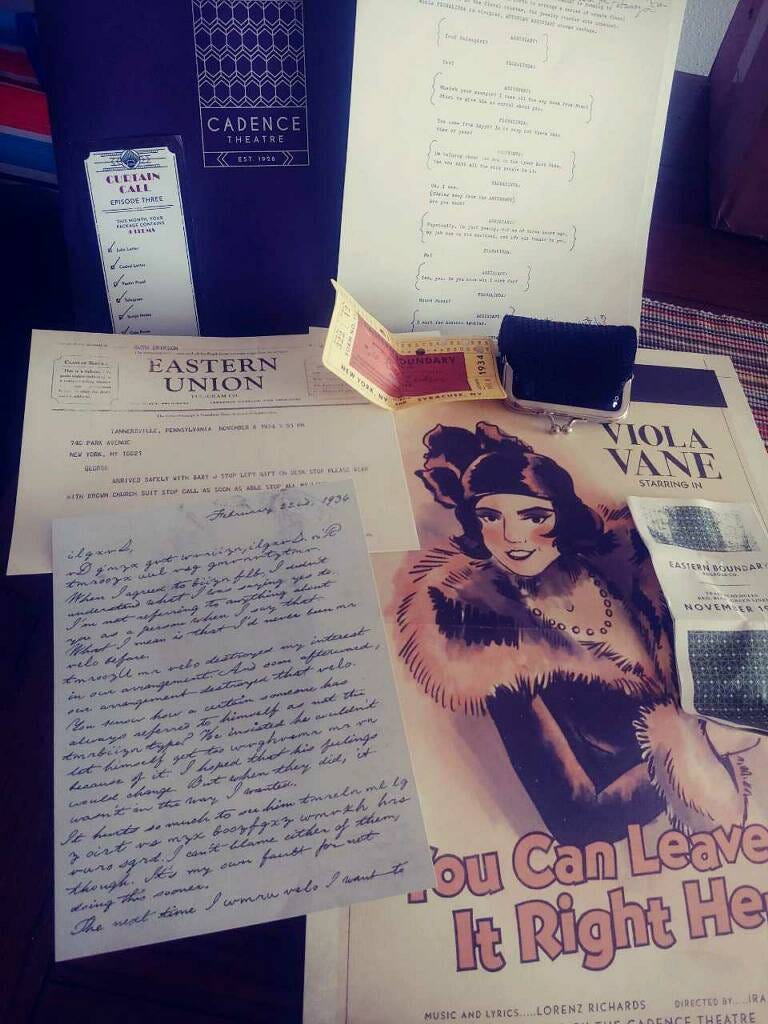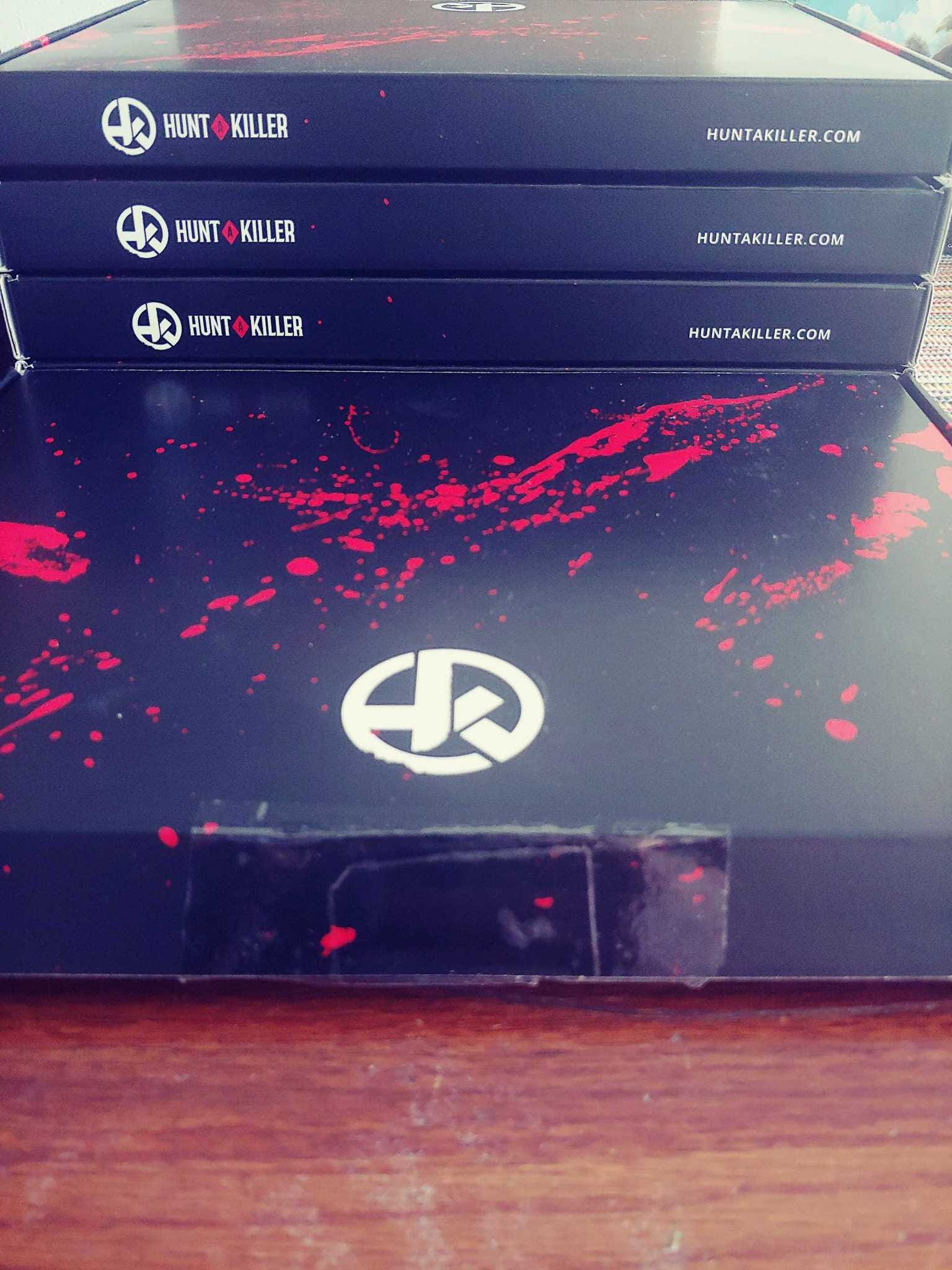
You’ve probably seen the advertisements on social media. The black boxes with the bloody handprint. The tagline about becoming a detective and solving the mystery as you, well, Hunt A Killer. I’ve seen the ads and while the concept looked intriguing, I’d never pulled the trigger on a subscription to the service.
For those unfamiliar, Hunt A Killer operates on a subscription model where you can sign up for a six or twelve-month package. Each season lasts six months and includes one box a month for the duration, which tells a complete story (so the twelve-month package nets you two stories over a year and lets you solve the mystery and find the killer). Inside each box, are a number of items ranging from notes and receipts to cuff links and cigarette cases that tie into the hunt for the murderer as well as a larger story for the season.
This review will ostensibly cover Curtain Call, which is the current season, but should be applicable to any Hunt A Killer set because the overall concept is the same from season to season just with different stories. I also want to note that, as part of this review, I received all six boxes at once, which is not the norm. There are ways to rush order them as part of the subscription, but they were all available to me and I could have blown through them all over a couple of nights. In an effort to at least sort of recreate the normal experience, I did try to space them out.
Going in, I had a few questions about Hunt A Killer:
How exactly does this work?
Is this something I would consider actually subscribing to?
Is this in any way, shape, or form immersive?
Now, I talked about how it generally plays, but let’s get into some specifics using Curtain Call as an example. Curtain Call opens with a letter from one Julia Adler who is trying to save her theater after a mummified body of a starlet from the 1930s was found in a trunk. She wants to keep the theater open, but the police won’t take the case, so she’s turned to you to solve the cold case and find out what happened all those years ago. To do that, you’ll need to sift through a variety of clues (the tactile element here makes for a great player experience) in each box where your goal will vary between determining the murder weapon, eliminating suspects, and finally — in the last box — discovering the killer.

Those are the main objectives in each box, and are the easiest thing to solve. In fact, I started this during the run of the elaborate alternate reality game ARCANA, quickly hit the first objective, and thought there must be something more to it because I was coming off the difficult puzzles in ARCANA. Thankfully, the monthly box doesn’t stop there, and would be, frankly, disappointing if it did. Additional objects in each box have different and usually pretty obvious ciphers or puzzle elements to them that, when solved, fill in the details of the characters in the story.
Get Kevin Gossett’s stories in your inbox
Join Medium for free to get updates from this writer.
SubscribeSubscribe
The difficulty level of these ciphers feels pretty good at the start of the box. There’s an in-game resource that lists the ciphers you’ll be using throughout the season, which can be helpful for figuring out how some of the puzzles will be solved (and you don’t have to look if you want to figure it all out on your own). This choice helps make the game accessible to people who may not have participated in something like this before. The main problem here is that while the ciphers and puzzles are fun to play with, there aren’t any new ones introduced throughout, so you end up using the same ones multiple times.
Curtain Call’s stories were pretty solid and kept with the 1930s New York City theater theme. There’s nothing here that will blow your socks off, but there are some twists and turns that flesh out the main mystery and make it worth it to totally finish each box. It also helps round out the whole experience of Hunt a Killer so it doesn’t feel like you’re laser focused on only one thing.
That long-winded explanation leads to the second question of whether I would consider a subscription and the answer is: yes, probably, but almost definitely while we’re still dealing with COVID-19.
I worked on these boxes with my wife and it was a nice stay at home date night activity. If you’ve got a roommate, partner, or other family member that you live with, this makes for a good time. There’s a sense of accomplishment on finishing a box and getting the right answer (which you email to an address that auto-responds with more story if you’re correct) and, at about 45–60 minutes to finish a box, it fits nicely into an evening without taking it over. And while so many other experiences right now are call or Zoom based, being able to touch the Hunt A Killer elements was welcome.
Which brings us to the last question. So, I’ll say, yeah, Hunt A Killer is as immersive as any other remote experience. Are they the most immersive thing you’re going to do right now? No. Now, you’re not interacting with actors or anything like that, but the service does bring you into a world and let you play around with the physical objects to uncover stories and solve puzzles. In some sense, it’s like a moderately immersive escape room.
And for people who aren’t familiar with immersive work, this feels like an excellent way to dip a toe into the immersive pool. While I was solving the boxes, I discovered the popular Facebook groups tied to the game where participants can ask for help. More than that though, they happily share how they feel like detectives cracking the case, get dressed up to get in the mood for working on the puzzles, or show off their elaborate murder boards, complete with red string.
I wasn’t really sure what to expect out of, but came away pleasantly surprised. Hunt A Killer won’t be anything groundbreaking for fans of immersive theatre. That doesn’t mean that there isn’t something to enjoy here though. It actually manages to check a decent number of the immersive boxes with physical items that deliver puzzles and a story you can interact with, if not affect the outcome. It’s a fun way to pass some time with a remote experience during quarantine and has the added bonus of feeling like you’re solving a mystery.
Hunt A Killer offers subscription services and other experiences. Boxes are $25/month, with premium experiences at $99 and up.
NoPro is a labor of love made possible by our generous Patreon backers. Join them today!
In addition to the No Proscenium web site, our podcast, and our newsletters, you can find NoPro on Twitter, Facebook, YouTube, Instagram, in the Facebook community Everything Immersive, and on our Slack forum.
Office facilities provided by Thymele Arts, in Los Angeles, CA.





















Discussion